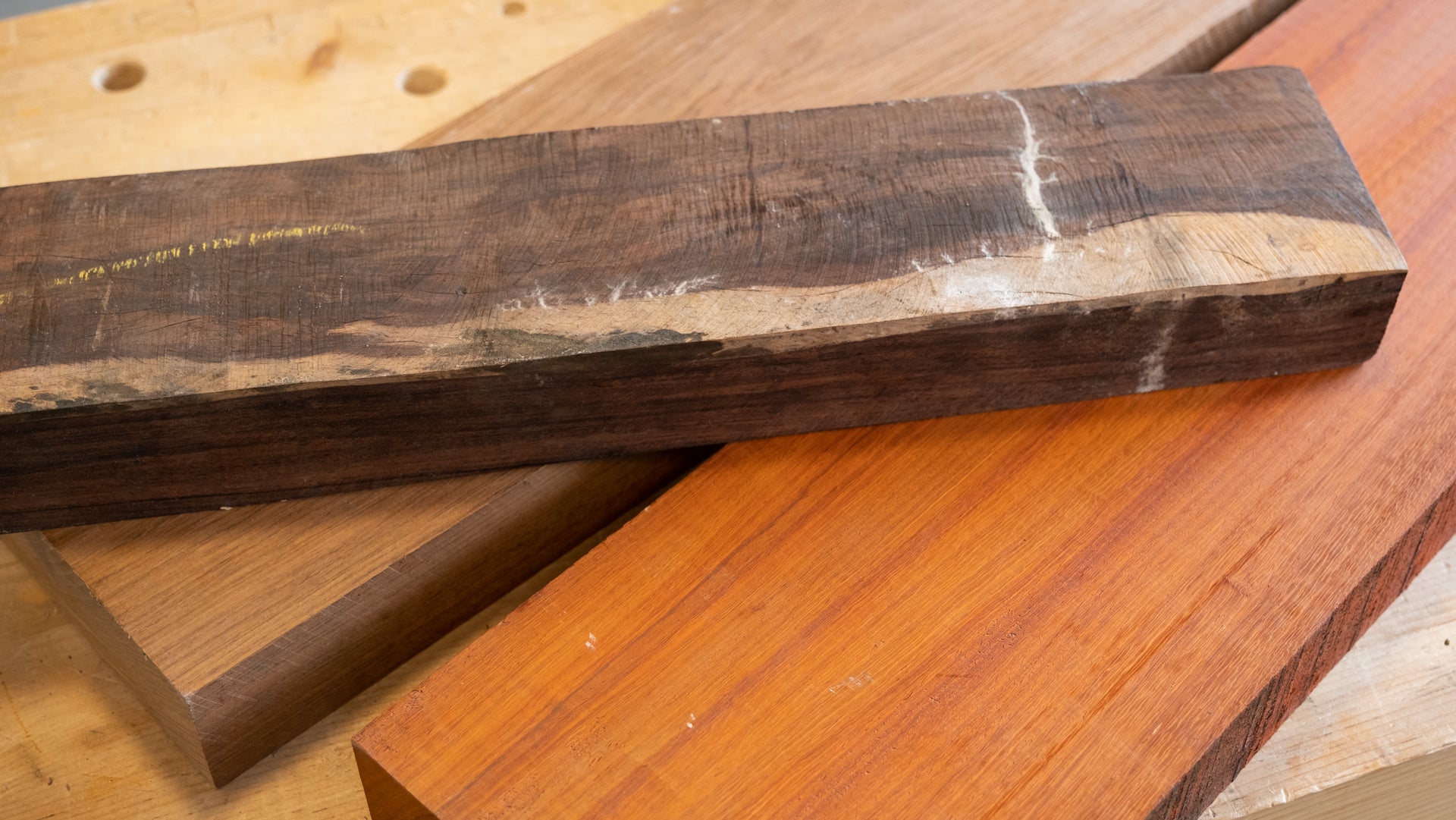Characteristics


Appearance
Freshly cut Purpleheart wood exhibits a greyish, purply brown colour. It turns into the familiar eggplant colour after a bit of time. Additional UV exposure turns it dark brown with a hint of purple.
Workability
Purpleheart hardwood is not known for its workability. This tough wood can easily dull tools. Plus, if cutters are dull or cause too much heat, Purpleheart will become gummy.
Uses
Purpleheart wood is an excellent choice for inlays and accent pieces that require a splash of colour. Other uses include furniture and woodworking projects.
Purpleheart Wood for a World of Applications
Historically, Purpleheart wood has been utilized in a variety of applications, from the construction of ancient weaponry to the creation of ceremonial objects. Today, its versatility shines through in an even wider range of uses. The rich, deep purple hue of Purpleheart hardwood lends a touch of uniqueness and luxury to high-end furniture pieces. Its hardness and durability ensure that items like tables, chairs, and cutting boards can withstand the test of time, making it a popular choice among furniture makers. Woodworkers often use Purpleheart for inlays and accents in various woodworking projects, including jewelry boxes and decorative panels. Its vivid colour contrasts beautifully with lighter woods, creating eye-catching designs.
The density of Purpleheart wood makes it ideal for turning on a lathe. Items such as bowls, vases, pens, and even chess pieces can be crafted from this wood, showcasing its colour and finish in objects that are both beautiful and functional. Incorporating Purpleheart hardwood into architectural elements such as stair treads, door frames, or window sills can add a unique aesthetic to any space. Its durability also means these details can endure over time, adding value and beauty to buildings and homes. Luthiers value Purpleheart for the construction of stringed instruments like guitars and violins. The wood's density contributes to excellent tonal qualities, while its appearance makes for stunning, one-of-a-kind instruments.
Purpleheart Categories
Purpleheart Products

The Colour-Shifting Splendor of Purpleheart Hardwood
The allure of Purpleheart hardwood lies not only in its renowned durability but also in its striking visual appeal. Initially, freshly cut Purpleheart wood boasts a light brown or dull grey appearance. But it undergoes a remarkable transformation upon exposure to air and light, developing its signature vibrant purple hue. This colour can range from deep eggplant to more vivid violet, depending on the specific piece and its growth conditions. The intensity of the colour can also vary within the same piece of wood, creating a rich tapestry of shades that adds depth and interest to any project. Purpleheart is known for its straight grain, though it can occasionally display wavy or interlocked patterns that enhance its visual complexity. The texture is generally fine and even, contributing to a smooth finish that highlights the wood's natural luster. When polished, Purpleheart wood can achieve a high sheen, accentuating its colour and making it an attractive choice for projects where aesthetics are crucial.
One of the most fascinating aspects of Purpleheart hardwood is its dynamic nature. Its colour evolves over time, especially with exposure to light. The wood displays its most vibrant purple tones when initially cut and finished. However, with prolonged exposure to sunlight, the colour can gradually darken to a brownish-purple or even a deep burgundy. This natural patina process is a testament to the wood's living character and can be slowed (but not entirely prevented) by applying UV-inhibiting finishes. Understanding and embracing these changes is part of the joy of working with Purpleheart. Each piece tells its own story, evolving with its environment and the passage of time, making it a truly dynamic and responsive material. Whether in furniture or artisanal creations, Purpleheart wood's appearance offers a unique combination of beauty, complexity, and character that enriches every project it graces.
Exploring Purpleheart Hardness
Purpleheart's hardness, rated at 2,520 Janka, directly affects its uses. The Janka test assesses wood's hardness by measuring the amount of force needed to embed a steel ball halfway into a block of wood. For comparison purposes, hard maple rates 1,450 Janka; white oak, 1,360 Janka; red oak, 1,290 Janka; and walnut, 1,010 Janka. It's essential to keep Purpleheart hardness in mind when working with this wood. Purpleheart can dull cutting tools, which causes further problems because dull cutters can cause Purpleheart wood to turn gummy. It's vital to stay vigilant when working with Purpleheart hardwood.






 91 Reviews
91 ReviewsPurpleheart wood for woodworking!
Choose from 2 different sizes of our 4/4 Purpleheart Rough Cut Lumber Packs; 10 Board feet or 20 Board Feet. We will carefully handpick an assortment of boards in the pack size of your choice.
Frequently Asked Questions About Purpleheart
Purpleheart's unique characteristics make it a popular wood to work with. As a trusted supplier of Purpleheart lumber, KJP Select Hardwoods has a wealth of knowledge to share. Read on for the information you need.
Is Purpleheart Wood Dangerous to Work With?
Purpleheart wood is relatively safe to work with. Although cases are rare, it can irritate the skin and eyes of susceptible people.
What Is Special About Purpleheart Wood?
Purpleheart wood is special because of its fantastic colouring, which can change over time. It also stands out for its hardness and density.
How Should I Finish Purpleheart Wood to Maintain Its Purple Colour?
To preserve the vibrant purple colour of Purpleheart wood, use a clear finish that has UV inhibitors, such as a high-quality polyurethane, varnish, or lacquer. These finishes can help slow the colour fading caused by exposure to sunlight. Keeping the finished pieces out of direct sunlight is also beneficial.
Where Does Purpleheart Hardwood Come From?
Purpleheart hardwood is primarily sourced from the tropical rainforests of Central and South America. It is harvested from the Peltogyne genus of trees, which thrive in these humid and dense forest environments.
Order Purpleheart Wood From KJP Select Hardwoods
KJP Select Hardwoods offers an excellent lineup of Purpleheart wood products, including raw lumber, S4S lumber and thins. You can even find Purpleheart turning blocks, dowels, and cutting board blanks in our collection. Check out our selection today and find the perfect piece of Purpleheart hardwood for your next project.













